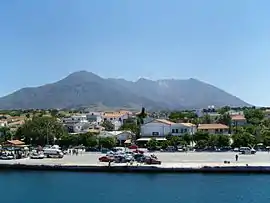Fengari
Fengari, also known as Saos (Greek: Σάος or Φεγγάρι) is the tallest mountain in the Aegean island of Samothrace, Greece, with an elevation of 1,611 metres (5,285 ft).
| Fengari | |
|---|---|
| Σάος | |
 | |
| Highest point | |
| Elevation | 1,611 m (5,285 ft) [1] |
| Prominence | 1,611 m (5,285 ft) [1] |
| Listing | Ultra |
| Coordinates | 40°27′29.45″N 25°33′31.66″E |
| Naming | |
| English translation | Moon |
| Language of name | greek |
| Geography | |
 Fengari Location in Greece | |
| Location | Samothrace, Greece |
| Climbing | |
| Easiest route | Hiking |
Etymology
The previous name of the mountain, Sàos, which means safe is still used in some maps. The current common name, though, is Fengari or Fenghári and it means moon.
According to a local legend, anyone who stands at the top of the mountain during the night of a full moon will see something that they wish for coming true. [2]
History
During classical antiquity, this mountain was very useful for sailors' navigation, due to its relative height and prominence.[3] In legend, Poseidon watched the Trojan War from the peak.[4]
Access to the summit
The easiest way to access the summit of Fengari is via the northern side of the mountain. During the summer, this area can contain considerable cloud and mist.[5] On clear days, though, the view from this area includes a large part of the northern Aegean Sea and stretches from the Troad in the East to Mount Athos in the West.[6]
Environment
Due its height and the diversity of its climate, many very interesting and rare plant species can be found on Fengari. On its cliffs and gorges, for example, polygonum icaricum can be found: this only grows in Samothrace and in Icaria. Several subspecies of potentilla montana also grow near the top of the mountain. In addition, the mountain contains a very rich and diverse variety of bird life.[7]
See also
- List of European ultra prominent peaks
References
- "Europe ultra-prominence". peaklist.org. Retrieved 2016-01-04.
- Lance Chilton; Marc Dubin; Mark Ellingham (2004). The Rough Guide to the Greek Islands. Rough Guides. p. 443. ISBN 9781843532590. Retrieved 2016-01-04.
- Giovanni Uggeri; et al. (2007). Paolo di Tarso: Archeologia - Storia - Ricezione (in Italian). Effatà Editrice. p. 250. ISBN 9788874025565. Retrieved 2016-01-04.
- "Mount Fengari".
- Mount Fengari. mountainsgreece.com. Archived from the original on 2016-03-04. Retrieved 2016-01-04.
- Dana Facaros; Michael Pauls (2007). The Greek Islands. New Holland. p. 598. ISBN 9781860113253. Archived from the original on 2016-03-04. Retrieved 2016-01-04.
- Bob Gibbons (2003). Greece. Oxford University Press. p. 127. ISBN 9780198504375. Retrieved 2016-01-04.
External links
- Hiking tours around the mountain (in English): samothraki.org
